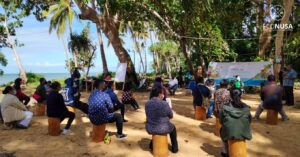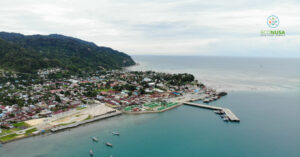
Hustle and bustle of the controversial Job Creation Law seem not to come to an end. Peoples kept on staging rallies to protest the simplification of 79 multi-sectors laws for job and investment creations. President Joko Widodo eventually signed off the Job Creation Law on 2 November 2020. The 1,187-pages Law is so-called the Law No. 11/2020 on Job Creation which came into effect including its stipulations since 2 November 2020.
On environment issues, the Job Creation Law interconnects with three regulations, namely: Law No. 32/2009 on Protection and Management of Environment, Law No. 18/2018 on Prevention and Eradication of Forest Destruction, and Law No. 41/1999 on Forestry.
Environmental conservation has drawn special attention due to the fact that the key articles on the law of forest and environment protection have been amended and even eliminated. Based on the summary conducted by the EcoNusa Foundation’s Advocacy and Public Policy, there are some issues that might cause some implications in forest and environment protection. The loss of the minimum limit of forest areas that should be upheld, the simplification of forest areas function amendment, and weakened sanction of violation are parts of the analysis.
Read also: Environment and Indigenous People in the Job Creation Law
In fact, eastern Indonesia, particularly Tanah Papua, is a tropical island with the richest biodiversity in the world. A study on Nature Journal recently mentioned that Papua island has more flora species than that of in Madagascar Island that was formerly dubbed the richest. There are 13,634 flora species in Papua, nearly 2,000-fold more than that of in Madagascar. As from the figures, 9,000 species are endemic. There are some to mention such as fire orchid, woton, selre (Papuan wine), iron orchid, dark fruit (piarawi), taer fruit, and red fruit as parts of the large number of endemic florae in Tanah Papua.
Based on Health Office’s Herbal Medicine and Concoction Research (RISTOJA) 2017, as from thousands of flora species in Tanah Papua, there are 983 flora species that serve as herbal medicine. Some other 529 flora species have been identified as herbal medicine with efficacy to cure an ailment.
Not only the diversity of flora, Tanah Papua also has 125 mammalians (55 percent endemic), 223 reptilian species (35 percent endemic), and 602 bird species (52 percent endemic). It ranges from paradise bird Cenderawasih, gold coated kangaroo, black winged parrot up to ekidna, living in the jungle and along the rivers in Tanah Papua.
Post-doctoral researcher of Royal Botanic Gardens, Kew, London and Zurich University in Swiss, Camara-Leret, called Papua island is a natural laboratory and one of the last frontiers of biodiversity in the world. The researcher found 68 percent of florae in this island do not exist in other places.

“The island is the natural laboratory in which we as evolution biologists use it as medium to study the fragmented landscape,” said Camara-Leret as quoted by Mongabay as saying.
Tanah Papua has the most intact primary forest block in the tropical areas. However, the loss of forest cover that keeps increasing in the last decade is due to the rising logging, mining, land clearance for industrial forest, and palm oil plantation. Based on EcoNusa data (2020), deforestation rate in Papua Province is 30,944 hectares per year and West Papua 4,436 hectares per year.
As to Camara-Leret, the diversity and endemic state of flora in Papua are very susceptible to threat due to the fact that certain flora species distribution only grows in a narrow habitat. Consequently, a large-scale land clearance will make these species vulnerable to extinction.
Furthermore, logging could cause paradoxes effect to the biodiversity. The number of species in a certain area will increase in a short time. But in a certain case, some species could hardly be developed despite their survival.
Through Manokwari Declaration in 2018, Papua and West Papua Provinces have committed to protect at least 70 percent of land to conserve biodiversity in which thousands of endemic flora and fauna exist. In the former Law on Forestry prior the Job Creation Law, the government strictly states that forest areas should be 30 percent of the river areas and or island with proportional distribution.
Unfortunately, the Job Creation Law eliminates the minimum forest area that should be upheld and thus it could potentially provide more opportunities for excessive exploitation of forests. Simplification and relaxation of license are also potentially giving loopholes for industry to explore Tanah Papua massively and trigger a far higher rate of deforestation.

“Amendment and elimination of key articles on environmental conservation in the Job Creation Law put ecological state in Tanah Papua at risk. Tanah Papua still has the largest forest cover in Indonesia despite its more vulnerability,” said Bustar Maitar, EcoNusa Foundation CEO, responding to the Job Creation Law.
The amendment and simplification of law in the Job Creation Law has potentially threaten the sustainability of forest and environment. Habitat and population of endemic flora and fauna in Papua island will be in jeopardy. Even with the absence of the Job Creation Law, much of the endemic flora and fauna in Papua is on the brink of extinction.
The National Flora and Fauna Day on 5 November should been a momentum for a reflection. Will the conservation of flora and fauna that have marked the identity of the Indonesian with its noteworthy richness of natural resources be in the prioritized list of the recently-sign off Job Creation Law?
Editor: Leo Wahyudi




